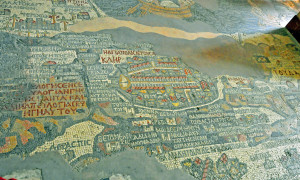Most visitors to Madaba, a small city near Mt. Nebo in northwestern Jordan, come just to see a floor. That famous floor guided both sixth century Christian pilgrims and twentieth century archaeologists to one of the largest churches of antiquity.
In about 1896, the builders of Madaba’s Church of St. George uncovered the floor of a Byzantine church built on the same site. The damaged floor included the remains of a large mosaic map of the area from Lebanon to the Nile Delta and from the Mediterranean to the eastern wilderness. The map, originally comprising about 2 million tiles, dates from about 570 A.D. and gave visitors to the Holy Land a visual understanding of the location of important Christian sites. It is the oldest known map of the area.
The map, with east at the top, identifies major locations in Greek. Near the center is an oversized representation of Jerusalem, bisected by a colonnaded main street (the “cardo”). In the middle of the cardo is the domed Church of the Holy Sepulchre, shown upside down with a red roof. Another church, with a slightly larger roof, is shown upright in the south (right) end of the cardo.
When the Madaba map was discovered, scholars assumed the church at the end of the cardo was the “Nea Church,” known from ancient records to have been built by Emperor Justinian in about 542 A.D. and reported to have been the largest church in Jerusalem at the time. But the church itself had never been found. After the capture of the Jewish Quarter of Jerusalem by Israel in 1967, archaeologists from the Hebrew University of Jerusalem, using the Madaba map as their guide, found the ruins of the Nea Church and the adjacent cardo about 12 feet below the current street level. Measurements showed that the Nea Church covered almost two acres, nearly twice the size of the famed Hagia Sophia in Constantinople.
Today’s visitors to Jerusalem can walk along the columns of the Roman cardo to the ruins of the Nea Church. Like their sixth century predecessors, they can thank the Madaba map makers for showing the way.
